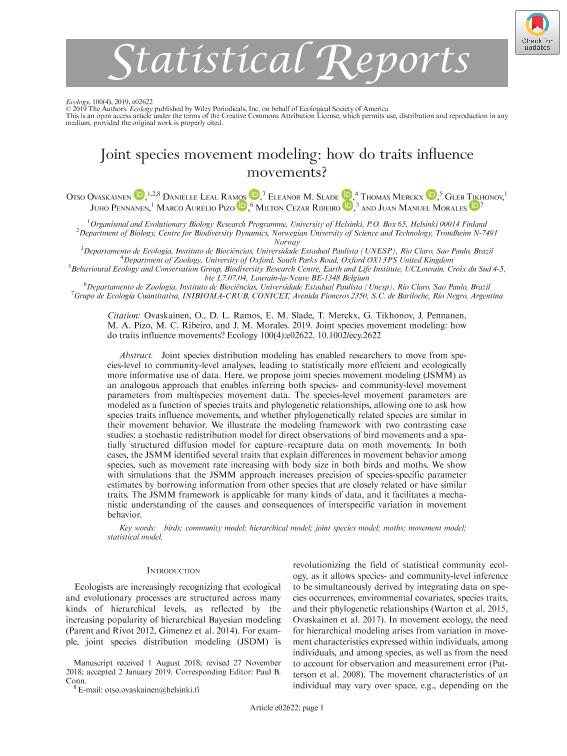Mostrar el registro sencillo del ítem
dc.contributor.author
Ovaskainen, Otso
dc.contributor.author
Leal Ramos, Danielle
dc.contributor.author
Slade, Eleanor
dc.contributor.author
Merckx, Thomas
dc.contributor.author
Tikhonov, Gleb
dc.contributor.author
Pennanen, Juho
dc.contributor.author
Pizo, Marco Aurélio
dc.contributor.author
Ribeiro, Milton Cezar
dc.contributor.author
Morales, Juan Manuel

dc.date.available
2020-07-30T11:32:46Z
dc.date.issued
2019-02
dc.identifier.citation
Ovaskainen, Otso; Leal Ramos, Danielle ; Slade, Eleanor; Merckx, Thomas; Tikhonov, Gleb; et al.; Joint species movement modeling: How do traits influence movements?; Ecological Society of America; Ecology; 100; 4; 2-2019; 1-8
dc.identifier.issn
0012-9658
dc.identifier.uri
http://hdl.handle.net/11336/110575
dc.description.abstract
Joint species distribution modeling has enabled researchers to move from species‐level to community‐level analyses, leading to statistically more efficient and ecologically more informative use of data. Here, we propose joint species movement modeling (JSMM) as an analogous approach that enables inferring both species‐ and community‐level movement parameters from multispecies movement data. The species‐level movement parameters are modeled as a function of species traits and phylogenetic relationships, allowing one to ask how species traits influence movements, and whether phylogenetically related species are similar in their movement behavior. We illustrate the modeling framework with two contrasting case studies: a stochastic redistribution model for direct observations of bird movements and a spatially structured diffusion model for capture–recapture data on moth movements. In both cases, the JSMM identified several traits that explain differences in movement behavior among species, such as movement rate increasing with body size in both birds and moths. We show with simulations that the JSMM approach increases precision of species‐specific parameter estimates by borrowing information from other species that are closely related or have similar traits. The JSMM framework is applicable for many kinds of data, and it facilitates a mechanistic understanding of the causes and consequences of interspecific variation in movement behavior.
dc.format
application/pdf
dc.language.iso
eng
dc.publisher
Ecological Society of America

dc.rights
info:eu-repo/semantics/openAccess
dc.rights.uri
https://creativecommons.org/licenses/by/2.5/ar/
dc.subject
COMUNITY MODEL
dc.subject
HIERARCHICAL MODEL
dc.subject
MOVEMENT MODEL
dc.subject.classification
Ecología

dc.subject.classification
Ciencias Biológicas

dc.subject.classification
CIENCIAS NATURALES Y EXACTAS

dc.title
Joint species movement modeling: How do traits influence movements?
dc.type
info:eu-repo/semantics/article
dc.type
info:ar-repo/semantics/artículo
dc.type
info:eu-repo/semantics/publishedVersion
dc.date.updated
2020-07-21T21:03:05Z
dc.identifier.eissn
1939-9170
dc.journal.volume
100
dc.journal.number
4
dc.journal.pagination
1-8
dc.journal.pais
Estados Unidos

dc.journal.ciudad
New York
dc.description.fil
Fil: Ovaskainen, Otso. Norwegian University of Science and Technology; Noruega. University of Helsinki; Finlandia
dc.description.fil
Fil: Leal Ramos, Danielle. Universidade Estadual Paulista Julio de Mesquita Filho; Brasil
dc.description.fil
Fil: Slade, Eleanor. University of Oxford; Reino Unido
dc.description.fil
Fil: Merckx, Thomas. Université Catholique de Louvain; Bélgica
dc.description.fil
Fil: Tikhonov, Gleb. University of Helsinki; Finlandia
dc.description.fil
Fil: Pennanen, Juho. University of Helsinki; Finlandia
dc.description.fil
Fil: Pizo, Marco Aurélio. Universidade Estadual Paulista Julio de Mesquita Filho; Brasil
dc.description.fil
Fil: Ribeiro, Milton Cezar. Universidade Estadual Paulista Julio de Mesquita Filho; Brasil
dc.description.fil
Fil: Morales, Juan Manuel. Consejo Nacional de Investigaciones Científicas y Técnicas. Centro Científico Tecnológico Conicet - Patagonia Norte. Instituto de Investigaciones en Biodiversidad y Medioambiente. Universidad Nacional del Comahue. Centro Regional Universidad Bariloche. Instituto de Investigaciones en Biodiversidad y Medioambiente; Argentina
dc.journal.title
Ecology

dc.relation.alternativeid
info:eu-repo/semantics/altIdentifier/url/https://esajournals.onlinelibrary.wiley.com/doi/full/10.1002/ecy.2622
dc.relation.alternativeid
info:eu-repo/semantics/altIdentifier/doi/http://dx.doi.org/10.1002/ecy.2622
Archivos asociados
